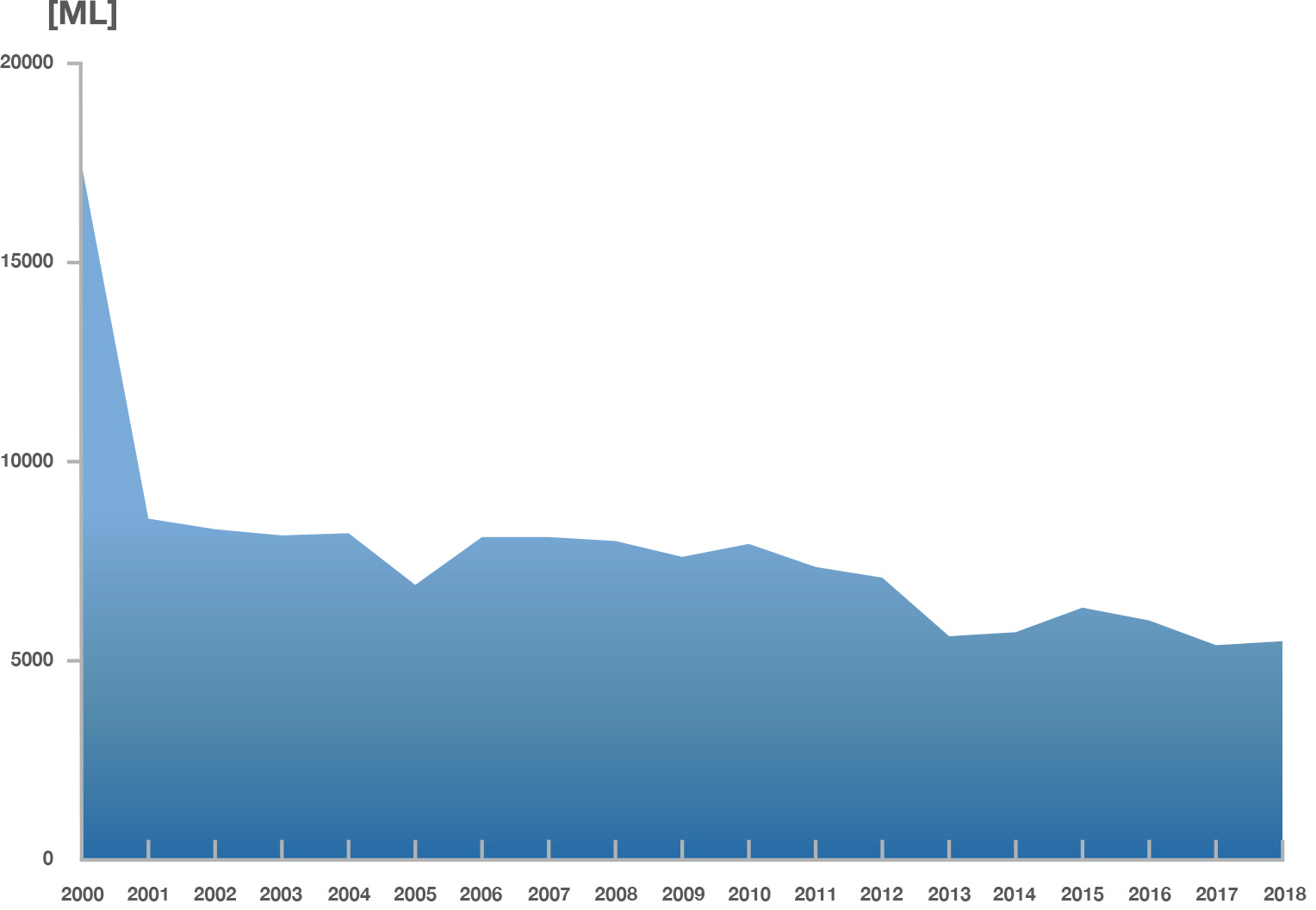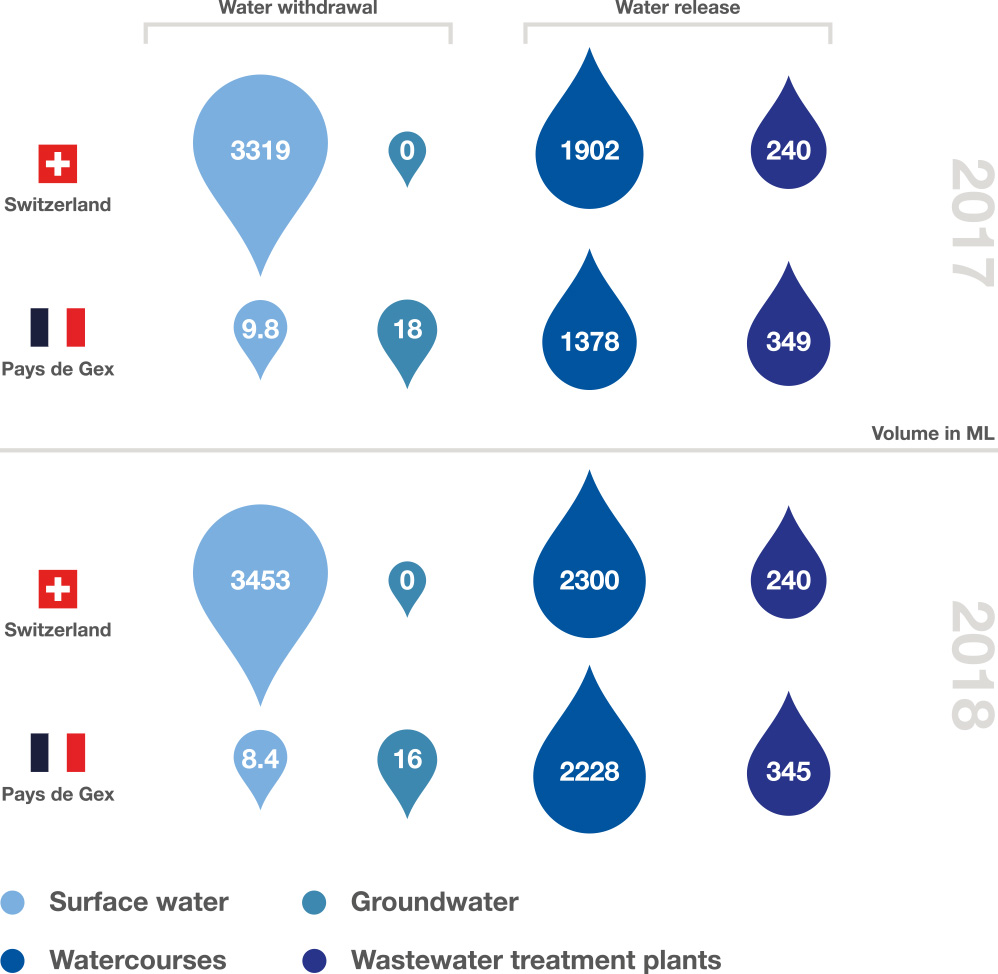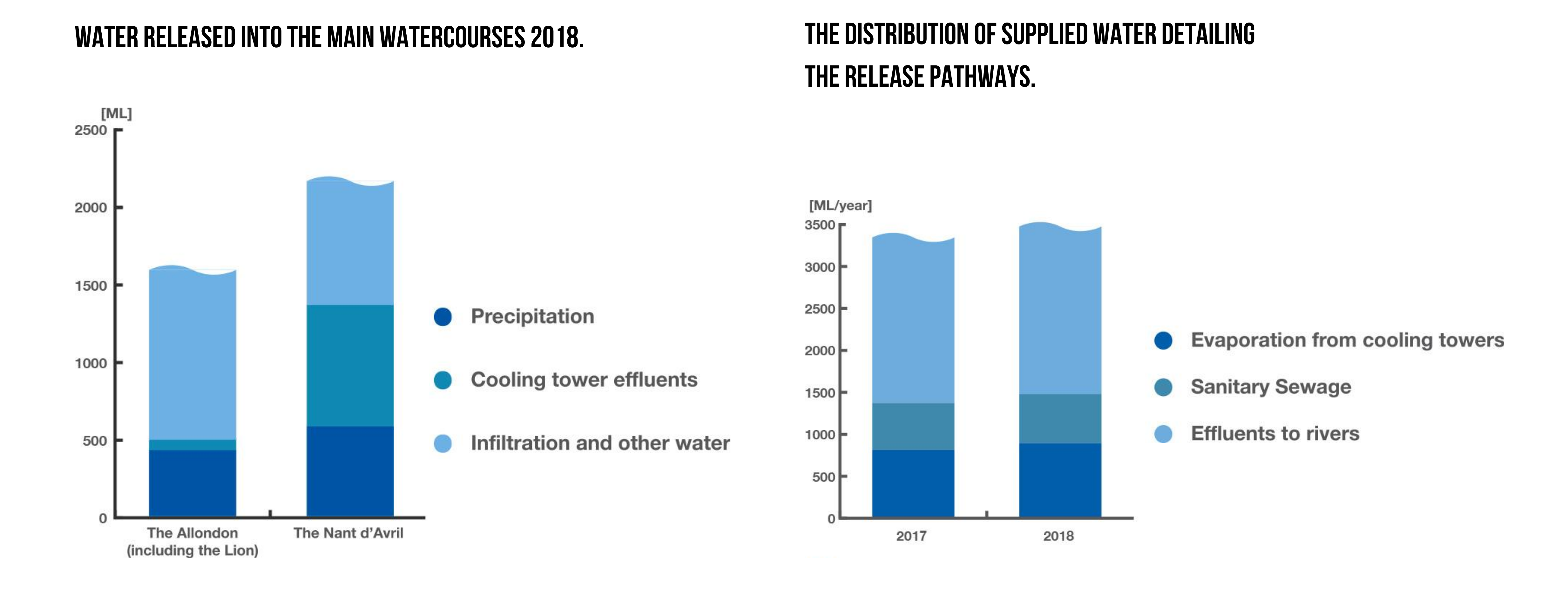 |
|
|
CERN’S ANNUAL WATER CONSUMPTION 2000 - 2018. Based on data from Services Industriels de Genève and Régie des Eaux Gessiennes. |
Water is essential for the cooling systems of CERN’s accelerator complex. These involve 21 cooling towers that evaporate a fraction of the water to cool the accelerators, and release another fraction as effluent water that may contain residuals of the products used to prevent scaling, corrosion, and bacteria including Legionella. CERN continuously monitors effluent quality and has procedures to mitigate the consequences in case of incident, and to alert the relevant Host State authorities. Responsible water management is of upmost importance for CERN. The Organization has a long-term programme to further reduce the concentration of chemicals in clean water releases, and commits to keeping the increase in water consumption below 5% up to the end of 2024, despite a growing demand for water cooling of upgraded facilities. Longer-term objectives will be set in future reports.
Water withdrawal and release
 |
|
|
TOTAL WATER WITHDRAWAL AND RELEASE 2017 - 2018. Withdrawal is based on data from Services Industriels de Genève and Régie des Eaux Gessiennes. Releases into watercourses are measured on-site. Data on wastewater treatment plants are measured by the Host States. |
In 2018, CERN consumed 3477 megalitres, ML, of water. All water supplied to CERN is of drinking water quality, some of which is processed to demineralised water. The majority of the water comes from Lake Geneva and is supplied by the Services Industriels de Genève. Less than 1% comes from Pays de Gex in France, a waterstressed area. It is supplied by the Régie des Eaux Gessiennes, and consists mainly of groundwater.
Around 80% of CERN’s water supply is dedicated to industrial activities, mostly the accelerator cooling system, and 20% is for sanitary purposes. CERN decreased its water consumption radically from 15 000 ML in 2000 to 3477 ML in 2018, principally by changing its cooling tower water circuits from open circuits to semi-open or closed ones.
The Organization releases rainwater, infiltration water and cooling water into local watercourses, some of which are small and sensitive to the quality of the effluents they receive. This is the case for the Nant d’Avril and Lion, a tributary of the Allondon and the Allondon itself. These watercourses are monitored by CERN and, independently, by Host State authorities. Any deviations from Host State legislation are rapidly investigated and treated. The Nant d’Avril receives the majority of the cooling water.
Managing water as a resource
CERN’s approach to water management is one of constant monitoring and improvement. The first priority is to minimise water consumption. The second is to optimise qualitative and quantitative aspects of the effluents released into watercourses. CERN has committed to the regional plan for the evacuation of water (Plan Régional d’Evacuation des Eaux, PREE) for the Nant d’Avril developed by the Canton of Geneva. In this context, CERN’s objectives by 2025 are to:
- Recycle cooling tower water to reduce and improve the quality of water released into the Lion and Nant d’Avril;
- Prevent accidental release of pollutants such as hydrocarbons in the Lion by implementing a retention basin at the main outlet of the Prévessin site. This will also regulate surface runoff during precipitation.
Further water retention solutions are being investigated for the Meyrin site within the scope of the PREE for the Nant d’Avril.
CERN has regular exchanges with local Host State authorities on water protection issues in the framework of the tripartite committee for the environment.
Monitoring water released into watercourses
The HSE Unit runs a monitoring programme on effluent water quality and quantity and regularly samples the neighbouring watercourses to evaluate the Laboratory’s environmental impact. CERN reports to the Host State authorities on a quarterly basis. Following past pollution events in the Lion, the monitoring programme was reinforced. No event that would have led to a fine or non-monetary sanction occured during the period covered by this report (see Environmental Compliance).
 |
|
|
(LEFT) WATER RELEASED INTO THE MAIN WATERCOURSES 2018. CERN releases water into nine distinct watercourses, of which the main receivers are the Nant d’Avril and the Allondon (83% of the total water released into watercourses). (RIGHT) THE DISTRIBUTION OF SUPPLIED WATER DETAILING THE RELEASE PATHWAYS. Data on evaporation and effluents are measured on-site. Data on sanitary sewage are measured by the Host States. This does not include the release of precipitation runoff or infiltration water. |
|
In focus
Serge Deleval is manager of CERN’s cooling tower project.
— What solutions has CERN adopted to improve the quality of water released from the cooling towers?
SD: The first solution involves the use of demineralised water in the cooling towers, while maintaining the releases in the site’s drainage network. The lower salt concentration of demineralised water improves evaporation, and therefore decreases water consumption. The use of chemicals is also reduced, improving the quality of released effluents. CERN is deploying this solution at the Meyrin site, which has a widespread demineralised water supply network.
The second solution involves recycling the water in the cooling tower circuits. To decrease water consumption and effluent volume, the water is treated and fed back into the circuits. Residual effluents from the treatment process are released into the sewage network instead of watercourses. This solution was implemented at the Prévessin site at the end of 2018 to reduce the impact on the Lion. By 2025, this solution will be applied to the LHC and SPS cooling tower circuits, reducing the impact on the Nant d’Avril.
Learn more
Questions regarding this report may be addressed to Environment.report@cern.ch.
